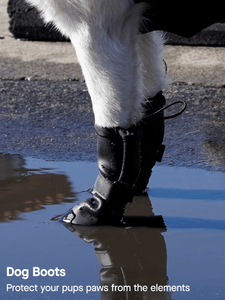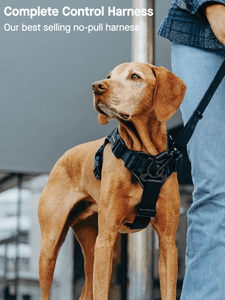Return to Blog
The Best No-Pull Dog Harnesses for Dogs Who Are Strong Pullers
By Canada Pooch on Sep 27, 2023
Does your dog constantly pull on the leash during walks? If so, investing in a no-pull dog harness can greatly improve your walking experience. In this article, we will explore the top-rated no-pull dog harnesses on the market for strong pullers. From understanding the benefits of using a no-pull harness to the key features that make them effective, this guide will help you find the perfect fit for your pup. Read on to discover how to put an end to those leash-pulling battles once and for all.
Understanding Dog Harnesses
Typical dog collars place pressure on your pet's neck, which can lead to unnecessary strain, especially in large and powerful big dogs. Therefore, a dog harness serves as a safer and more comfortable alternative. It redistributes force across a larger area of your big dog's body, reducing the risk of injury.
But not all harnesses are created equal, for big dogs with a habit of pulling, no-pull dog harnesses come in especially handy.
The Function of a No-Pull Dog Harness
No-pull dog harnesses are thoughtfully engineered and designed to gently yet effectively discourage your dog from pulling on walks. The way they function is by lightly tightening around your dog's chest area when they attempt to pull or lunge forward. This causes a sensation that encourages your dog to stop pulling so that the pressure is released. A key feature of our no-pull harnesses is a leash attachment point positioned at the chest instead of the back. This strategic front-clip configuration gives owners much better control because when a large, powerful dog tries to pull forcefully, the harness automatically steers the dog's momentum back towards the owner - naturally and seamlessly putting an end to the unwanted pulling behavior. It redirects them into an upright, controlled position by their side.
How to Find the Right Fit
While understanding these distinctive traits is critical, knowing how to find the right fit for your dog's harness is just as important for the comfort and security of your big dog. Start by measuring your dog's girth (the widest part of its chest), and neck. Then, compare your results with our size chart to find the proper fit for your pup. Always ensure the harness fits snugly but not too tight; you should be able to fit two fingers between the harness and your dog's skin.
Consider your Dog's Size and Breed Before Buying
Size matters when it comes to choosing the right pull dog harness. Always consider your dog's size and breed before making a purchase. Remember, what works for a poodle may not be the best for a St. Bernard.
A no-pull mesh harness like The Everything Harness Mesh Series at Canada Pooch, could be ideal for smaller breeds as they are lighter and provide more flexibility. On the other hand, a robust harness like the Complete Control Harness could be the go-to for larger breeds due to its durability and strength.
Harnesses built with robust nylon webbing are best for strong pullers; they can handle big dogs without compromising their safety. Big dogs often require harnesses with extra padding and sturdiness. A padded chest and back offer additional comfort and help distribute the pressure evenly across the body.
Remember, a well-fitted harness can prevent possible injuries and keep your pup comfortable during their walks.
The Key Features to Look for in No-Pull Dog Harnesses
There are a few key features to consider when considering no-pull dog harnesses. These include a comfortable and padded chest plate, sturdy webbing, adjustable straps, and a well-positioned leash attachment points.
A padded chest plate can offer extra comfort for your big dogs, while sturdy webbing provides the durability needed for dogs that are strong pullers. Adjustable straps are also essential to ensure a good fit, while the leash attachment point on every pull dog harness must be strategically positioned to discourage pulling behaviors.
Tips for Teaching Your Dog to Stop Pulling:
Getting your dog to stop pulling on the leash is one of the most common training challenges dog owners face. It can be frustrating when your dog is constantly pulling during walks, but with positive training methods and a bit of patience, you can teach even stubborn pullers to walk politely on a loose leash. Here are some of the top tips for stopping leash pulling and improving your dog's walking manners.
Use Proper Equipment
One of the best things you can do is use equipment designed to discourage pulling. A no-pull dog harness, like the Complete Control Harness, is ideal for this purpose. These specially designed harnesses redirect your dog's forward momentum when they pull, making the behavior self-correcting. They apply gentle pressure across the chest and shoulders without constricting other areas. This steers your dog back toward you rather than allowing them to pull forward. High-quality no-pull harnesses are comfortable for dogs and give you much better control.
Test out any new harness in your home first and watch how your dog reacts. They should be able to move comfortably while you assess the fit. Introducing it slowly with positive associations will help your dog accept wearing the harness happily. Bring plenty of tasty treats on those first harness walks!
Reward Good Behavior
When you're starting leash training, reward your dog frequently with treats and praise for walking next to you without pulling. Use high-value treats like small pieces of chicken, cheese, or hot dog to make this extra motivating. Reward not just when your dog is heeling perfectly, but for any step in the right direction, like glancing back at you or taking just a few steps without pulling. This positive reinforcement helps your dog understand the behavior you want.
Don't wait for your dog to be in perfect heel position before rewarding. Catch them doing well even if it's just momentarily walking next to you without pulling and let them know that's exactly what you want. Be patient as your dog figures out this new way of walking.
Practice in Low-Distraction Areas
Take some time to practice polite leash walking indoors or in your own yard first. Areas without a lot of distractions will set your dog up for success. Once they understand the behavior, challenge them by taking the training out on real walks. If your dog starts pulling again when overstimulated, turn and walk the other way to reinforce that pulling gets them nowhere.
Start by working in a quiet room without the temptation of windows or doors. Keep initial sessions very short - just a few minutes at a time. Increase duration slowly as your dog masters the skills. Next step it up by practicing in your own fenced yard. Finally, head out for short neighborhood walks, avoiding busy areas at first. If your dog regresses, go back to an easier environment and rebuild their confidence.
Remain Patient and Consistent
Changing behavior takes time, so remember to be patient with your dog as the training progresses. Stick with the same equipment, cues, and reward-based methods rather than switching between different techniques too frequently. Consistency is key when teaching new skills. With regular short training sessions, even dogs who pull persistently can learn better leash manners.
Leash training requires daily practice to see lasting results. Keep sessions short, positive and fun so you and your dog both stay motivated. If either of you feel frustrated, take a break and come back to it later. End each session on a good note by rewarding something your dog did right.
Consistency takes vigilance but it's essential. With time and practice your dog will associate walking next to you without pulling as the norm, not the exception.
No-pull dog harnesses can be an effective tool for managing strong pulling behavior in dogs. Through the exploration of various types of harnesses and their features, it is evident that these products can provide both comfort and control while walking or training dogs. By distributing the force evenly across the body, these harnesses discourage pulling behavior without causing harm or discomfort. Additionally, the inclusion of adjustable straps and buckles allows for a customized fit, ensuring the harness remains secure during walks or outings. The blog has emphasized the importance of positive reinforcement and consistent training in conjunction with using a no-pull harness for the best results. Dog parents must prioritize understanding their pet's unique needs and selecting the most appropriate harness to effectively address their pulling issues. Overall, no-pull harnesses offer a humane and practical solution for strong pullers, enabling dog owners to enjoy pleasant walks and improve their bond with their pups.


